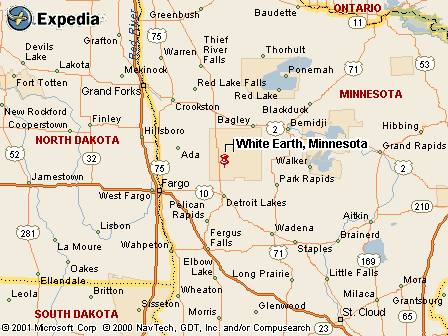|
|
Canku Ota |
|
|
(Many Paths) |
||
|
An Online Newsletter Celebrating Native America |
||
|
July 14, 2001 - Issue 40 |
||
|
|
||
|
Anishinaabe Horse Program Teaches Values, Tribal Historical Ties to Animals |
||
|
by: BEN LATHROP, Staff Writer Detroit Lakes Tribune-June 27, 2001 |
 Sheldon Shebala sits erect on the paint horse, cowboy boots in the stirrups, black waist-length
braids dangling from beneath a white cowboy hat. Sheldon Shebala sits erect on the paint horse, cowboy boots in the stirrups, black waist-length
braids dangling from beneath a white cowboy hat."This here is Ronald," he tells the two dozen kids standing outside the corral, eager (or nervous) for their turn to ride. "I just met him yesterday. He seems to be a really nice horse." Shebala would know. He and his brother Sonsela have lived among horses all their lives, on a ranch on the Nez Perce Indian Reservation in Idaho. Sheldon, 23, is an animal science major at the University of Idaho and an aspiring veterinarian; he's also an experienced breeder. Since 1992, he and his family have been producing a distinctive breed of horses called the Nez Perce breed. The Sheblas hire youth to work on the ranch and teach them about horses - riding them, breeding them, knowing them. For the next three weeks, though, the Shebala brothers are taking a break from their work at the ranch to teach kids - and adults - the fundamentals of horse riding at the White Earth Recovery Project farm some 30 miles northeast of Detroit Lakes. The three-week "Anishinaabe Horse Program," as it's called, is the brainchild of WELRP director Winona LaDuke, who would like to implement a permanent program similar to the Shebalas'. "I was just quite taken with the whole program," LaDuke said. "We hope to inspire youth to aspire toward similar excellence." This is the first step. The WERLP has a dozen horses, and the Shebalas are available from 9 a.m. to 7 p.m. every day to offer instruction - not only to Anishinaabe kids, but to the general public (the charge is $4 for youth and $8 for adults). Actually, the WELRP has been sponsoring an after-school riding program - geared for young women - twice a year since the fall of 1999. "The whole intent was to build self-esteem and identity," said WERLP community organizer Robynn Carter. LaDuke said the after-school program was targeted for "at-risk" kids. "A lot of youth respond better to animals than they do to humans," she said. It wasn't just about riding horses. "You can teach a lot of things with a horse," said LaDuke. Participants learned about anatomy, history, Anishinaabe culture and the Ojibwe language. They also learned confidence. LaDuke says relating to a horse teaches trust and responsibility. "It's those kinds of things that help you build confidence. ... It's a lot different from spending your day shopping." A highlight of the program was a trip with 35 students last year to visit the Nez Perce Reservation. The youth got to ride horses in the mountains. "They came back totally excited about horses," Carter says. One student, Tabatha Chilton, who will be a junior next year, couldn't make the trip, but she participated in the after-school program. Now she's volunteering with the current program, helping other kids learn how to ride. Chilton says she was scared at first about the prospect of riding a horse, but now she's confident in her horsemanship. "I know how to ride," she says sanguinely. "You've just got to talk to them." At the farm on Tuesday, the 25 kids from the Naytahwasuh Sports Facility and the summer recreation program got more than a lesson in how to ride horses. Sheldon also told them about the horses he breeds. "Indians - we don't have our own breed of horses," he said. According to LaDuke, the Nez Perce Indians stole horses from the Spaniards and developed the appaloosa. "They're known for their smoothness of gait, their strength, their endurance," she said. But most of the horses were killed by the cavalry in the Nez Perce War. Now, finally, the Nez Perce Indians have begun developing their own breed of horses. The Nez Perce horse is a cross between the appaloosa and the akhalteke, another horse known for its hardiness. "We want a horse that can run long distances," Sheldon told the kids. Eventually, the WELRP may get into breeding horses of its own - an Anishinaabe breed, perhaps. LaDuke also hopes to bring in different instructors for each season. She said there's a professional jockey, Nicki Goodwin, who lives right on the reservation. "I think that (the program) has had an impact," LaDuke said, adding that it's an ongoing thing. "It's not just about one experience." To reserve a time for trail riding and/or instruction, call Robynn Carter at 1-888-779-3577. |
|
|
|
White Earth Land Recovery Project |
|
|
||
|
|
||
| Canku Ota is a free Newsletter celebrating Native America, its traditions and accomplishments . We do not provide subscriber or visitor names to anyone. Some articles presented in Canku Ota may contain copyright material. We have received appropriate permissions for republishing any articles. Material appearing here is distributed without profit or monetary gain to those who have expressed an interest. This is in accordance with Title 17 U.S.C. section 107. | ||
|
Canku Ota is a copyright © 2000, 2001 of Vicki Lockard and Paul Barry. |
||
|
|
|
|
|
The "Canku Ota - A Newsletter Celebrating Native America" web site and its design is the |
||
|
Copyright © 1999, 2000, 2001 of Paul C. Barry. |
||
|
All Rights Reserved. |
||

